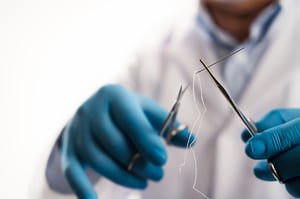Are Surgery Students Losing the Dexterity to Stitch?
 From shrinking attention spans to lost sleep, there’s no shortage of claims spending too much time in front of screens can negatively impact our health. But a professor of surgery at Imperial College in London warns of another unexpected implication, specifically for surgery students: loss of the dexterity to stitch.
From shrinking attention spans to lost sleep, there’s no shortage of claims spending too much time in front of screens can negatively impact our health. But a professor of surgery at Imperial College in London warns of another unexpected implication, specifically for surgery students: loss of the dexterity to stitch.
While today’s surgical students may score high grades, they’re spending too much time interacting with computers and mobile devices, and too little time using their hands, according to Professor Kneebone. Which means sewing up patients (something once considered routine) has become much more challenging.
So why are screens the culprit, and what can surgical students do to regain this critical skill?
How Screens Reduce the Dexterity to Stitch
Thanks to technology, many tasks people once completed manually have been reduced to a few keystrokes or a swipe of a touchscreen. For example, writing down appointments in a physical calendar.
But as it turns out, dexterity issues begin much earlier than medical school. Young children are struggling to hold pencils due to excessive technology use, according to a report shared by The Guardian. This lack of hand strength can lead to further complications later in life — especially for those who choose to pursue a career as a surgeon.
Additionally, government policy’s impact on education may hold some of the blame, too. Because there is so much emphasis placed on performance in core academics like math and science, and little-to-no emphasis on creative subjects, students have fewer opportunities to use their hands during their formative years.
How Schools and Healthcare Organizations Can Improve Stitching Dexterity
While a generation growing up in a tech-driven world may face a slight disadvantage in terms of hand strength, students and surgeons can overcome these setbacks by rebuilding their dexterity. Here are a few suggestions for helping strengthen your hands and fingers:
- Use a squeeze ball: Hold a stress ball in your palm and squeeze it as hard as possible for 3 to 5 seconds, release and repeat 10 times for each hand. Do this at least three times a week, with at least one day in between each session.
- Exercise your fingers: Place your hand down on a flat surface, and then lift and lower your index finger. Repeat this process for each finger until you reach the pinkie, and then reverse your order and complete the exercise five times on each hand.
- Find a related hobby: Sewing or knitting replicate many of the hand and finger movements necessary for suturing patients. By practicing one of these hobbies several times a week, you can build up necessary strength and muscle memory.
While technology provides a wealth of opportunities and advantages for the medical community, hand dexterity is essential to success as a surgeon. By taking the time to improve your dexterity, you can ensure you’re able to perform all your duties with ease and improve surgical outcomes.




